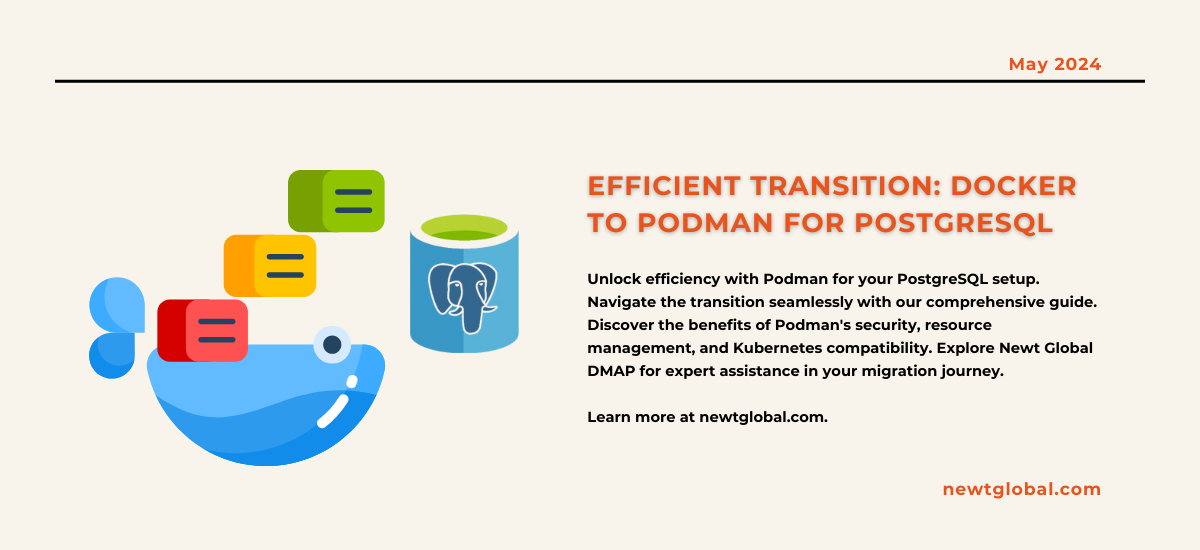
In the world of container technology, switching from Docker to Podman is a big deal for developers and businesses. Especially when dealing with important systems like PostgreSQL databases, it’s crucial to plan carefully to keep things running smoothly and efficiently. Podman is gaining attention because it doesn’t need a main controlling program like Docker does, and it follows certain standards that make it a good choice. But moving from Docker to Podman requires careful preparation to make the most of its benefits. This article explains the important steps and things to think about when moving a Dockerized PostgreSQL setup to Podman, making the transition as smooth as possible.
Migrating to Podman
Before we get into specific advice, let’s talk about why we’re moving from Docker to Podman:
-
- No Need for Root Access: Podman works without needing special access, which makes it more secure.
-
- Compatibility: Podman is designed to be a direct replacement for Docker, so it can handle Docker’s setup files with only small adjustments.
-
- Uses Resources Wisely: Podman doesn’t use as much of your computer’s resources as Docker does.
-
- Better for Developers: Podman has features that make it easier to move between development and production stages, like being able to create Kubernetes setup files from Podman commands.
Dockerized PostgreSQL to Podman
-
- Plan Carefully: First, look closely at how your PostgreSQL setup works in Docker. Understand what it depends on, how it’s connected to other parts of your system, and any special settings you’ve made. This will help you plan the move and see what problems might come up.
-
- Test Before Making Changes: Before you start changing things in your main setup, make a copy of your PostgreSQL setup in a test area. This lets you find and fix any problems without risking your real data.
-
- Use Podman’s Compatibility: Podman can understand Docker’s setup files and commands, so take advantage of that. It makes the switch easier because you can keep using familiar commands.
-
- Move Data Safely: Keeping your data safe is the most important part of moving a database. Use PostgreSQL’s built-in tools to back up your data and move it securely. Then, make sure everything looks right after the move.
-
- Update Your Automation and Deployment: If you have scripts or tools that automatically manage your Docker setup, you’ll need to update them to work with Podman. Podman commands are similar to Docker’s, but there are some differences to watch out for.
Common Pitfalls
-
- Don’t Rush: It’s tempting to move everything to Podman all at once, but it’s better to take your time. Moving gradually helps you find and fix problems without causing too much trouble.
-
- Watch Out for Networking Changes: Podman might handle networking differently than Docker does, especially when it comes to connecting different parts of your setup. Make sure your network settings still work after the move.
-
- Keep Security in Mind: Podman is more secure than Docker in some ways, but you still need to be careful. Follow security best practices and make sure your team knows how to use Podman safely.
-
- Train Your Team: Make sure everyone on your team knows how to use Podman and understands how it’s different from Docker. Updating your documentation and doing some training sessions can make the transition easier.
-
- Ask for Help if You Need It: Podman has a strong community of users who are happy to help. If you run into problems, don’t hesitate to ask for advice.
Moving from Docker to Podman for your PostgreSQL can make things more secure, use resources better, and work well with Kubernetes, which is important for modern software development. Following the right steps and being aware of possible issues can help make this move smooth.
Maximize Efficiency with Newt Global DMAP
Finally, the message talks about a blog from Newt Global’s DMAP, which seems to offer advice on making this transition smoothly, focusing on the benefits of Podman in terms of security, ease of use, and efficiency. Planning your move carefully, making sure your data is transferred safely, and adjusting your network settings are key steps.
As you consider embarking on this journey or any major database migration, particularly from Oracle DB to cloud-native PostgreSQL, it’s essential to have the right partner to guide you through. Newt Global DMAP is a world-class product designed to enable mass migration of Oracle DB to cloud-native PostgreSQL faster, better, and cheaper. Our expertise and innovative approach can significantly streamline your migration process, reducing complexity and ensuring a seamless transition.
Interested in learning more about how Newt Global DMAP can transform your database migration experience? Visit us at newtglobal.com for more information and insights. For any inquiries or to discuss your specific migration needs, please reach out to us at marketing@newtglobalcorp.com. Join the ranks of those efficiently navigating the evolution of container technologies with Newt Global DMAP at your side.
